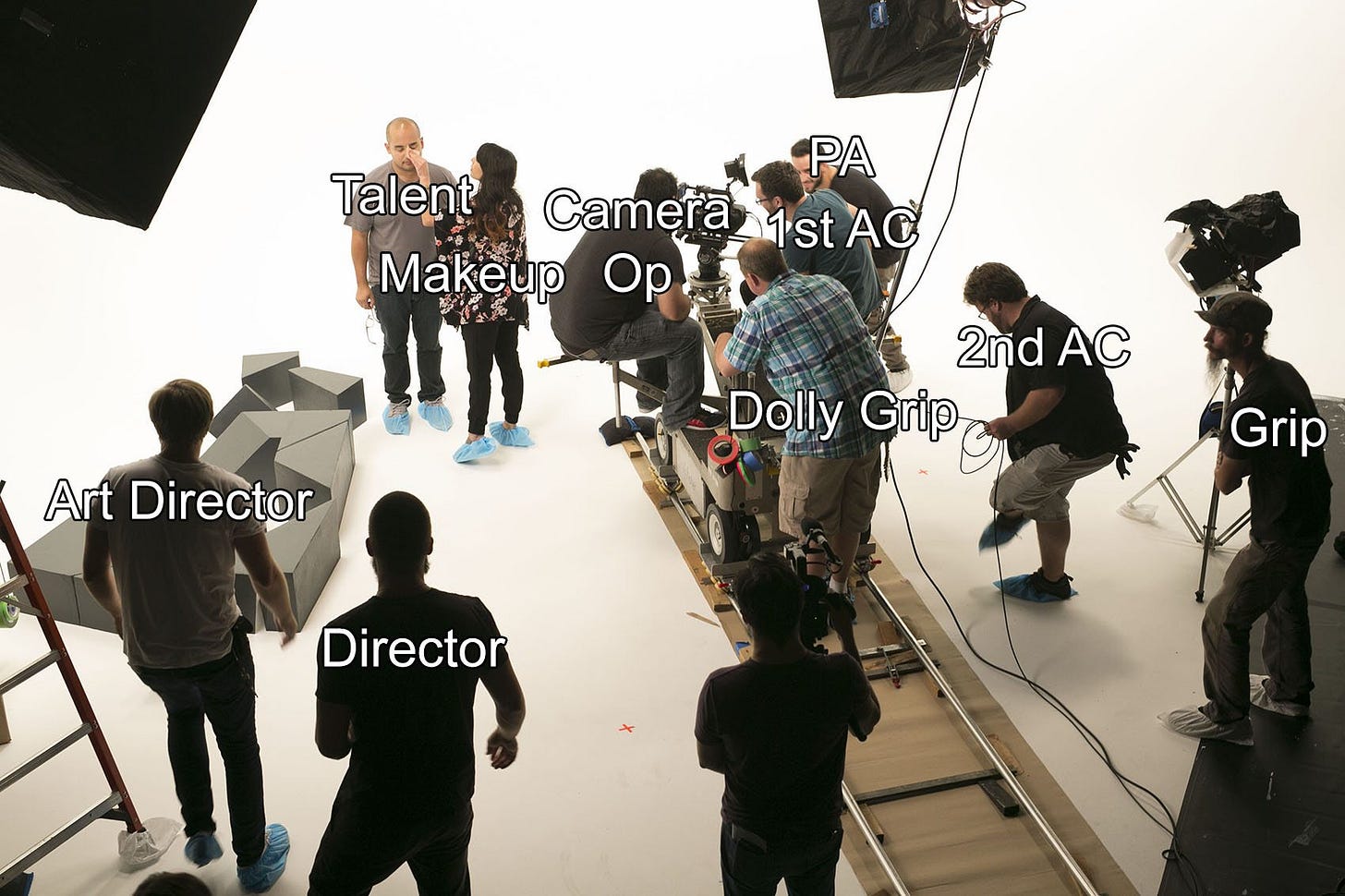Time To Begin Again: A New Path for Nova Scotia’s Screen Industry
You don’t build a future by being a film crew for hire. You build it by owning the story.
The future of Nova Scotia’s screen industry starts with one simple,
undeniable truth: we have a problem. Until we recognize and confront
this reality together, we will continue to waste time and resources,
missing the opportunity to build something lasting, sustainable, and
globally competitive.
The time to face the facts and change course is now.
The economics and intention of the screen industry in Nova Scotia is at a crossroads. While some celebrate short-term successes, the broader picture reveals a dramatic decline in both domestic and foreign production. Despite the rising global demand for content, the money is flowing elsewhere—into mergers, platform giants, foreign IP, and outdated systems that offer little benefit to local creators. For years, we've been stuck in a cycle of service production and arts-driven incentives, pushing young creators into unsustainable models that leave them without ownership or long-term success.
This paper proposes a new direction: one that prioritizes Nova Scotia-owned intellectual property (IP), incentivizes local investment in our own work, builds a vertically integrated industry, and creates a Maritime Channel as the focused foundation for lasting, commercially viable content. The goal is clear—ensure local ownership of stories, keep our capital building wealth at home, global market access, and a future where Nova Scotia doesn’t just serve as a backdrop for other people’s dreams but becomes a hub for our own stories to be told to the world.
It’s time to demand our fair share of federal resources, rethink outdated policies, and build a screen industry that truly serves Nova Scotians—now and into the future.
Executive Summary: We Need a New Direction for Nova Scotia’s Screen Industry
The Current Situation
In 2024, Nova Scotia mistakenly celebrated the screen industries as a success, but the broader industry picture tells a different story. Production, both domestic and foreign, has declined dramatically across Canada and globally, a trend that has worsened even before the political and economic turmoil brought by Trump, tariffs, and trade wars.The Problem: Where the Money’s Going
Despite rising demand for content, most of the revenue in the screen industry is going elsewhere:To mergers and acquisitions in the media landscape, where the value is extracted from libraries of content, not new creations.
To platform giants (Netflix, Amazon, Meta), which take the lion's share of revenue before it reaches content creators.
To foreign IP owners and service productions, where Nova Scotia provides labor but not ownership.
To legacy institutions that fund outdated systems and workflows, leaving little for true innovation.
With Tariff and trade threats, more and more production investment will be staying local, but the demand for content will continue to be international.
Most significantly, YouTube is now the primary platform for creators, shifting cultural power and ad revenue away from traditional media.
The Service Production Illusion
The idea that service production (producing for foreign studios) brings lasting value is a myth. While it provides short-term jobs, it does not build sustainable, globally competitive companies in Nova Scotia. The local industry is dependent on external sources of capital, with little growth in Canadian-owned intellectual property.Beyond Arts Funding
For too long, Nova Scotia's screen industry has been overly focused on 101-level arts incentives, unintentionally encouraging young creators to adopt a primarily arts-driven mindset. While artistic expression is vital, this has led many creators to focus more on producing one-off, project-based work rather than developing sustainable, commercially viable content. By shifting our focus to building scalable, long-term intellectual property, we can foster a new generation of creators who are equipped to thrive in the global market, not just the arts scene. This shift will empower local creators to prioritize ownership and commercial intent, ensuring that their work is built to last and reach broader audiences.
The Solution: Focus on Nova Scotia-Owned IP
The solution is to refocus our efforts on building Nova Scotia-owned content that is both commercially viable and export-ready. Instead of relying on foreign productions, we need to develop an ecosystem where local creators own their content and benefit from its global distribution.Plan for Change: Building a Vertically Integrated Industry
To transition from a service-based industry to a sustainable, locally owned model, we propose a vertically integrated industry strategy. This involves:Developing a regional Maritime Channel as a foundation stone that commissions and licenses content owned by Nova Scotians.
Ensuring content is created with global markets in mind, focusing on ownership, scalability, and export potential.
Prioritizing content creators and local ownership, ensuring that the rights, profits, and creative control stay within the province.
Addressing the Allocation Gap: Fair Share of Federal Resources
Nova Scotia’s fair share of federal screen industry funding is about 2.58%, reflecting its population. However, the province is currently receiving far less than its fair share. We must demand a recalibration of funding allocation from Ottawa to ensure that Nova Scotia’s screen industry receives a fair and proportional share of national resources, supporting local creators and building long-term growth. The federal programs and departments must do whatever is required to ensure fair regional allocation first, and pursue any other priorities second.The Uneven Playing Field: Toronto’s Dominance
The screen industry in Canada has become increasingly centralized in Toronto, leaving regional producers with limited access to funding, resources, and distribution opportunities. Federal policies must recognize and support the unique realities of regional markets.A New Structure: Locally Owned, Export-Oriented, Creator-Centered
There have been no new Nova Scotia production companies with the intention to create locally owned, commercially viable content established since the end of the Film Tax Credit nearly ten years ago. The new model must prioritize:Ownership of rights and commercial intent.
Local production companies employing our own capital, building global partnerships, and distributing worldwide.
Creators at the center of decision-making, with the power to control their stories and products.
A strong independent infrastructure, free from institutional gatekeeping.
The Maritime Channel: The Key to Our Future
The Maritime Channel will serve as the cornerstone of this new industry model:A platform for locally owned and commercially viable content.
A tool to grow IP and build a global audience.
A catalyst for creating an integrated industry ecosystem, from production to distribution.
The Call to Action
The time to act is now. Nova Scotia must demand its fair share of federal screen industry funding, support small, monetized creators, and restructure Screen Nova Scotia to serve local creators, over managing service production. By building Maritime-owned content and investing in global distribution, we can create a sustainable, export-oriented screen industry that serves not just the province, but the world.
RELATED:
Today the New York Times reflected: If you entered media in the ’90s — magazine publishing, newspaper journalism, photography, graphic design, advertising, music, film, TV — there’s a good chance that you are now doing something else for work. We spoke to members of Gen X who now find themselves shut out, economically and culturally, from their chosen fields.
FRONTLINE NEWS FROM HOLLYWOOD:
Canadian Screen Industries:
The Current Situation
Here’s an overview of 2024 in the Canadian screen industries. Folks like to say that Nova Scotia had its best year ever in 2024, that this justifies optimism and further investment, and that it means the future looks bright.
No one is more of an optimist than me. But that’s a wrong reading of the situation. Nova Scotia is a tiny sample. We need to look at the International industry: In steep decline, the US industry: in steep decline, and the Canadian industry: in steep decline.
Total production, Canadian production, and foreign investment were all down in 2024 — a dramatic, steep, and uncontrolled decline with no mitigating factors and no reason to expect a turn around… and that was all BEFORE Trump, Tariffs, and Trade Wars.
Where’s The Money Going?
“But wait!” you say. Demand for content is up! People are consuming more and faster than ever in history. People are starved for entertainment. They want more and better. They’re bingeing on it. And their willingness to pay, in terms of subscription pricing and ad watching, has never been greater.
There are several contributing answers to where the money is going:
It’s going to mergers and acquisition deals. Warner buys Discovery. Disney buys Nat Geo. Paramount buys Smithsonian. And then they in turn get bought and refinanced. And along the way the money men realize… ever if they don’t make any new content, the libraries, the IP, still earns. People will watch what they are given to watch. It’s a habit. The M&A deals can vampire the free cash flow from these libraries for years. The same thing is happening in music and publishing. It’s a unique vulnerability of the entertainment industry.
It’s going upstream—to platforms, not producers.
The tech giants own the pipes. Netflix, Amazon, Meta. They take the lion’s share of revenue before a dollar reaches the people making the content.
It’s going to foreign IP owners—not local storytellers.
Canada hosts the shoot, but Los Angeles owns the rights. We rent the gear, they keep the gold.
It’s going to legacy institutions running on old maps.
Public money still flows to slow, centralized broadcasters and stale content pipelines, leaving creators on the outside looking in.
It’s going to middle layers—not makers.
Administrative costs, overhead, consultants, real estate (yes, I’m looking at you, 250 Front Street, Toronto), and endless rounds of paperwork and mandated non-commercial goals burn through resources before a single scene is filmed.
But most of all: ***It’s going to YouTube.***
That’s where the audiences are. That’s where the ad revenue is. That’s where the careers are being built—and where the cultural power is shifting.
Not later. Not someday. Now.
Today, YouTube pays out more to creators than Netflix and Spotify combined. They’re a bigger Podcasting platform than Apple.
More minutes watched daily than Netflix, Facebook, and TikTok combined in many global markets.
More daily users under 35 than any cable channel on Earth.
More content uploaded in 24 hours than legacy broadcasters air in a year.
And if we want our stories to matter in this new world, we need to build the bridges, policies, and platforms that get Nova Scotians from the edge of the industry to the very centre of it.
RELATED:
The Future of YouTube is Our Future
DISCLOSURE: I own Goog stock - the company that owns YouTube. But if I could Parlay Pick any stock it would be YouTube (more detail below)
Good People in a Bad Situation
Before anything else, let me say this clearly: this isn't a takedown. It's not a finger-pointing exercise or a public airing of grievances. It's certainly not an indictment of the hardworking, talented people who have kept Nova Scotia's screen industry alive through years of change, loss, and reinvention.
I know—firsthand—how much creativity, grit, and compromise it's taken to keep cameras rolling in this province.
But there are moments when loyalty to the past becomes a liability for the future. There comes a time when optimism and stupidity become almost synonymous. And right now, as global conditions shift, and as the fragility of our current model is exposed, I believe this is one of those moments.
It’s time we stop.
Not pause. Not pivot. Not plead for more of the same or try to buy back what we had.
But stop—and begin again.
Not because what we built was wrong — the service production side of the business has always been part of the bigger picture of local industry — but because the world we built it for no longer exists in a steady, sustainable way. And the world that's coming demands something stronger, smarter, and more sovereign.
We have an opportunity—right now—to reshape the future of Nova Scotia's screen industry. Not to wait and hope, but to act with intention. To move from being a workshop for someone else’s dreams to a factory for our own. That’s the goal. And it’s not only possible, it’s necessary.
What follows is not a critique of character, but a call to courage.
Let’s begin again. Together.
There is no polite way to say it: we’ve wasted seven years chasing the wrong dream.
Since the Tax Credit debacle and the institution of the film tax “incentive”, Screen Nova Scotia and its institutional partners have prioritized foreign service production more so than building a strong industry that we own. They’ve banked on the idea that if we just build the infrastructure—soundstages, crews, rebate models—the Americans will come. And they did, sometimes. But this passive, service-based approach has left us vulnerable, dependent, and unready for the kind of simple and predictable change in the business climate we’re now facing. It’s not a storm that’s now gathering on the horizon exactly, but it’s a blow that our first little pigs business model can not withstand.
Donald Trump’s threatened tariffs on Canadian film and television production make little sense. But they introduce an intolerable amount of risk for service production and open a Pandora’s box for digital trade generally. But maybe we should thank him. Because whether or not he changes his mind as he does, the message should be clear: this isn’t a stable foundation. It never was.
Nova Scotia screen industry needs to consciously stop what we’re doing and begin again.
RELATED:
What’s Your Damage, Hollywood?
Hollywood’s in panic mode—and not just because of AI. Productions are collapsing, music jobs are vanishing, and now the entire global screen industry is staring down the barrel of a political stunt with world-changing consequences.
The Service Illusion
For seven years, the pitch was simple: service production brings jobs, brings money, builds skills. And it does, in short bursts. But it also builds nothing lasting — nothing stable. It has not led to the creation of more local production companies with global market share. In fact what we once correctly called the Nova Scotia Film Development Corporation hasn’t developed any new companies in a meaningful, commercially viable way in the last seven years. It has not grown our intellectual property assets. It has not raised our writers, producers, or directors to national or international prominence. It has not created a cultural footprint. It has created dependency.
We built ourselves to be a workshop for other people’s dreams. Now we need to build a factory for our own.
What We Should Have Done (and Still Can)
Instead of shaping ourselves into a rebate appendage of Hollywood, we should have spent the last seven years investing in a vertically integrated local industry—an ecosystem of production companies, training programs, broadcasters, financiers, and global distribution channels that are ours. That own content, not just deliver labor.
It’s not too late.
We must refocus every conversation, every grant, every mentorship, every incentive, and every policy on building Nova Scotian-owned intellectual property first and nurturing opportunities for service production second.
No more just hoping to catch a big one. Let’s grow our own.
This starts with the provincial government, agencies, and leaders taking a strong clear message to Ottawa and the federal agencies now rethinking our industry, including CMF, Telefilm, and CBC. Nova Scotia represents about 2.58% of Canada in terms of population. We won’t settle for anything less than 2.58% of all federal screen industry funding, programs, and legislative support. And we will earn, through our efforts at least 2.58% of the Canadian industry.
Nova Scotia’s Screen Industry: Falling Short of Its Fair Share
A sensible place to start on a new path is to be clear on where we are going - where we should be. This is a simple calculation of what workers and Nova Scotian citizens should reasonably expect from our Screen Industries investment.
Canada’s screen industry is worth billions. But how much of that value stays here in Nova Scotia, supporting our writers, directors, producers, crews, and storytellers?
In the most recent fiscal year (2023–24), the total value of non-service screen production in Canada—meaning productions that are Canadian-owned, Canadian-content certified, and not just shot here for foreign studios—was $4.85 billion.
This is the portion of the industry Canada consistently has control of and administers through programs, agencies, and incentives like CBC, Telefilm, NFB, CAVCO, and CMF.
If Nova Scotia received a proportional share based on its population (which is about 2.58% of Canada’s total), we should have seen approximately $124.9 million worth of that industry generated here.
But the reality is starkly different.
After accounting for service production (foreign projects shot in Nova Scotia, often using local crews but with ownership, profit, and creative control residing elsewhere), the actual value of Nova Scotia’s non-service production in 2023–24 was just $60.7 million. (It’s important to note that these numbers are… suspect at best. They need to be recalculated, verified, and segmented into important value categories.)
That’s barely half of our, modestly estimated fair share.
The shortfall—more than $64 million annually—represents lost opportunities for Nova Scotia creators, lost income for our workforce, and lost ownership of stories that could be told from right here, to the world. It’s a gap that adds up year over year, not just in dollars, but in infrastructure, momentum, and cultural capital.
Nova Scotia punches well above its weight in beauty, talent, and originality. But we are being underfed at the national table. And that makes the case not for more handouts—but for a recalibration. A policy shift. A local commitment to grow our own stories, not just rent out the scenery for someone else’s.
Bottom line: With good management and a fair allocation of our federal industry resources Nova Scotia’s local industry should be double its current size.
The Uneven Playing Field: Toronto’s Dominance and the Diversity Dilemma
It’s a difficult truth, but one that must be said plainly: the domestic Canadian screen industry is increasingly centralized in Toronto—and the consequences for regional producers are mounting.
For decades, Toronto has been the gravitational centre of Canadian media. The headquarters of the CBC at 250 Front Street, the clustering of private broadcasters, major distributors, and talent agencies, and the dense network of service providers all reinforce the city’s dominance. But in recent years, consolidation has accelerated. CBC, for example, has brought more and more of its operations in-house and into the city. The orbit has tightened. For independent producers outside the Toronto core—especially those in Atlantic Canada—access has grown more limited, while influence has drifted further out of reach.
Compounding this is a newer, more delicate challenge: the implementation of well-meaning programs to advance diversity, equity, and inclusion in the industry. These initiatives are vital. But as currently designed, they often unintentionally sideline regional producers.
Many rural and smaller regions, through no fault of their own, cannot yet meet diversity quotas that are calibrated to the demographics of large urban centres. The result? Regional producers may find themselves ineligible for funding, hiring incentives, or distribution partnerships—not because their stories aren’t good or their teams aren’t skilled, but because the box-ticking requirements were built for a different ecosystem with a different demographic pool. That’s not fairness. That’s attrition by policy.
And somebody’s got to say it.
The solution isn’t to abandon equity goals—but to rethink how they’re applied. Program design must recognize regional realities. Provinces from coast to coast are remarkably aligned on one point: regional allocation must come first, with other program objectives—no matter how virtuous—built in with flexibility, not rigidity.
Right now, this approach stands in contrast to the publicly stated goals of organizations like the CBC, Telefilm Canada, and the Canada Media Fund. And because those goals shape eligibility criteria and funding guidelines, they cascade through the entire system, from development grants to final distribution.
If we believe in a truly national screen industry, we need policies that treat regional producers not as exceptions to be accommodated, but as essential partners in telling Canada’s full story. It’s not enough to spotlight the regions. We have to fund them.
The Hidden Barrier: How a Low Down - Down Low Policy Shift Quietly Crippled Nova Scotia's Screen Industry
It’s a little-known fact, but one of the most damaging changes the McNeil government made to Nova Scotia’s screen industry wasn’t the cancellation of the film tax credit—it was a quietly buried, unpublicized edit to the province's Equity Tax Credit (ETC).
In a move so underhanded it could hardly come under the heading of policy, the government rewrote the rules to specifically exclude film, television, and broadcast production companies from accessing the ETC. This meant that no screen-based company—not even local broadcast channels or production studios—could raise capital within Nova Scotia while offering investors the tax credit benefits available to other industries.
The effect was as expected. The ETC had been used in Nova Scotia to capitalize media company start ups and grow companies during the industry's high-growth years. From Salter St to Arcadia, if you ever wondered how we got the capital locally to build our companies, this is it. It helped attract private capital in Nova Scotia, build local ownership, and scale companies that could compete and sell to the world. When this avenue was quietly cut off, it didn’t just affect one budget year—it structurally redirected investment away from the creative sector and toward sectors like tech and biotech. Valuable sectors, yes. But not our home field.
This is a main contributor to why there have been no commercially focused new media companies since (because there simply is no other access to start-up capital like this in Nova Scotia) and why regular Nova Scotians are no longer incentivized to invest in our own popular growth industries and share in their successes.
And just in case there was any doubt about how misguided the policy was: Under this same policy thinking, the McNeil government also chose that same moment to exclude construction and real estate development companies from the tax credit as well. Two of the most foundational, employment-generating, and capital-intensive sectors in the province—cut off at the knees. Now we’re 27,000 homes short of what’s needed in Nova Scotia, and with construction lag, that number is expected to grow to close to double that in 5-10 years. All because Mr. McNeil fell victim to radical austerity economists in the Nova Scotia Department of Finance.
A New Structure
This begins with a new structure for the Nova Scotian industry, one that is:
Vertically Integrated: Development, production, distribution, and monetization should be built into the same strategy—not siloed off.
Locally Owned: The rights, profits, and control of Nova Scotian stories must belong to Nova Scotians.
Export-Oriented: We must create content for the world, not just for internal grant cycles, local cable provider commitments, or the Canadian arts system.
Creator-Centered: Writers, showrunners, and producers must be at the heart of this, not an afterthought.
Institutionally Independent: We need a culture of risk, not appeasement. That means independence from institutions that serve more to preserve the status quo than to create value.
Vertical Integration and commercialization means starting with a local customer for the product. We already have the audience - a million in Nova Scotia and 3 million in the region. This is a discerning audience, raised on deep storytelling traditions, as varied in mind and manner as any in the world. If we can inform, entertain, and delight this audience here at home, we can do it anywhere. But we have to get to them.
A strong export product requires a discerning local market that not only appreciates quality but also drives the commercial viability of content. Currently, there is no such market in the Maritimes for content that encourages a commercially viable approach to production—one that would generate value for global markets. This gap in the local ecosystem limits the potential for Maritime producers to scale their content beyond regional borders.
A regional Maritime channel platform dedicated to commissioning and licensing content could enable us to access this amazing audience. Through this platform, we will incentivize the development of popular, commercially viable programming tailored for both local audiences and international distribution. The channel will act as a catalyst for producing content that has global appeal, supporting the transition from niche, arts-focused programming to mainstream, market-driven content creation.
By fostering a commercial approach to content development in the Maritimes, we can aim to establish a sustainable model where locally produced shows can not only thrive within our own region but also find a place on global platforms. This initiative will not only bolster the region's cultural sector but also build the infrastructure necessary to create high-value content for international markets.
The lack of a local market for local commercial content currently defines our problem and limits our potential. CBC, national broadcasters, and cable companies have need been able to fill this core need for a viable industry. No amount of investment in production or production infrastructure will return anything but costs until this problem is solved.
A Call to Courage
This is not a criticism of individual crew or talent. It’s a systemic critique—and a call to courage. It’s the beginning of an overdue conversation about where we are and where our bosses — the taxpayers of Nova Scotia — need us to go.
We’ve been so focused on being grateful for scraps from the global industry, we’re missing the notion that in the new industry, we could own our own table.
So here it is. A challenge to everyone in Screen Nova Scotia, the Department of Communities, Culture and Heritage, our training institutions, our unions, our investors, and our artists:
Let’s stop chasing approval from people who don’t live here, don’t work here, and don’t care what happens after wrap day.
Let’s begin again—with a clear, deliberate, and bold goal: Build a Nova Scotian-owned industry for Nova Scotian-made stories that the whole world can watch.
The clock’s ticking. Trump or not, the old model is breaking.
And that might be the best thing that ever happened to us.
What Needs to Happen Now
We’ve made the case. The numbers are clear. The imbalance is real.
Now it’s time to act.
Nova Scotia must fight for its fair share.
Our provincial delegation—government officials, industry leaders, and screen professionals—must go to Ottawa and make the case for regional equity in screen industry funding. Not as a plea, but as a principled stand. This is about national balance. It’s about economic justice. And it’s about unlocking the full potential of Nova Scotia’s creative economy. We have a fully staffed, fully funded, screen advocacy agency. But it’s doing the wrong work. We need to reallocate its resources to work with the new federal government to ensure our region and all regions’ fair share of the creative economy.We must adjust the Digital Media Tax Credit.
Nova Scotia is uniquely positioned to lead the country in grassroots, creator-driven screen production—especially online. By tweaking the eligibility rules of our Digital Media Tax Credit to support small, monetized creators (like YouTubers, streamers, and indie podcasters), we can create a new competitive regional advantage. These creators are building IP, attracting audiences, generating revenue, and hiring locally. With the right policy, we can accelerate that growth and own more of the value we help generate.Screen Nova Scotia must be transformed—radically.
It’s no longer enough to be a polite participant on the legacy media, wine-and-cheese junket circuit. We need a new Screen Nova Scotia, rebuilt from the ground up as a powerhouse distribution network, a regional broadcast platform, and a fierce advocacy agency. It must lead the charge in bringing home our fair share from Ottawa. It must serve creators, not just productions. And it must see its job not as gatekeeping grants, but as cultivating value—through IP, audiences, exports, and equity.The Equity Tax Credit - A Simple Fix With Exponential Return
Here’s the good news: we don’t need a revolution to fix this. We just need a line item. All that’s required is a simple amendment to the Nova Scotia Equity Tax Credit Act to re-include film, television, broadcast, and screen-based media companies as eligible sectors. No new legislation. No massive budget ask. Just a quiet reversal of a dumb and bitter move.
Reinstating ETC eligibility for screen and broadcast companies would:
Reopen private capital pathways for Nova Scotia-owned production and distribution firms
Encourage the creation of Maritime-owned IP and commercially viable content
Support the development of digital-first broadcast platforms like the Maritime Channel
Leverage federal and international co-financing by demonstrating local investment
Enable career-building enterprises to grow from Nova Scotia, rather than drift away
In the post-streaming world, content is capital. And capital is what allows us to own our stories, our companies, and our futures. Restoring the ETC to include screen production is not just a policy tweak—it’s a strategic reset for an industry that can once again become a pillar of Nova Scotia’s economy.
We don’t need a new program. We just need to fix the one we quietly broke.
A Maritime Channel: Our Vertical Integration Solution
To build a real screen industry in the Maritimes—not just a support sector—we need more than tax credits and production subsidies. We need a platform. One that connects creators to audiences, ideas to markets, and content to capital. One that completes the circuit from development to distribution.
That’s what the Maritime Channel would be.
Not another grant program. Not a vanity stream. But a modern, regional answer to what the Knowledge Network is for British Columbia or TVO has been for Ontario—a publicly accessible, commercially focused platform for locally owned, globally minded screen content.
Available to all viewers in Nova Scotia and the Maritimes across digital, broadcast, and on-demand platforms, the channel would serve as the anchor of a vertically integrated industry strategy. Its mission: to help Maritime creators shape and pitch their work for the world—not just for grants or juries.
Instead of mirroring existing systems that reward:
Service production (which exports value),
Industrial work-for-hire (which builds other people’s IP), or
Purely artistic programming (which may win awards but rarely sustains careers),
…the Maritime Channel would prioritize:
Ownership of rights
Commercial intent from day one
Repeatable formats, exportable stories, and monetizable series
It would encourage and showcase projects with international potential, developed and retained here, with Maritime creatives owning their IP, building their audiences, and growing their companies.
This is how we build not just content—but continuity. Not just production—but a marketplace. Not just culture—but an industry.
This isn’t just about fairness. It’s about foresight. The future of Canada’s screen industry doesn’t belong to any one city. It belongs to every region that’s ready to build, to tell its own stories, and to make the system work for the many—not just the few.
Let’s make Nova Scotia that place.
RELATED:
Canada’s Film Future: Boom or Bust
As a favourite filming location for Tinseltown's big-budget productions, Canada has always been ready for its close-up—even when it's doubling for somewhere else! But what happens if there is suddenly a 25% tax on Canadian service production?
Lights, Camera… Tariff! Can Canada’s Screen Industry Survive?
Canada may not be the 51st state. But it acts as a stand-in for states all the time in film and TV.
























